Comprehensive Case Study: Contract Law and Partnership Issues
VerifiedAdded on 2023/06/07
|7
|2420
|266
Case Study
AI Summary
This assignment presents two legal scenarios involving contract law and partnership. The first scenario examines whether a valid contract exists between a hair salon (Ming's) and its customers based on an advertisement offering discounted haircuts. It analyzes the elements of offer, acceptance, and consideration, concluding that a contract exists with customers who presented the advertisement before its revocation. The second scenario explores a potential partnership between Lucy, Seamus, and Koo, assessing whether a partnership exists based on their business activities and intentions. It also addresses issues such as liability for purchases, breach of partnership duties, discovering partner identities, the impact of a partner's death, and determining partnership property. The analysis applies relevant sections of the Partnership Act 1891 to determine the rights and responsibilities of the parties involved. Desklib provides access to similar solved assignments and study resources for students.
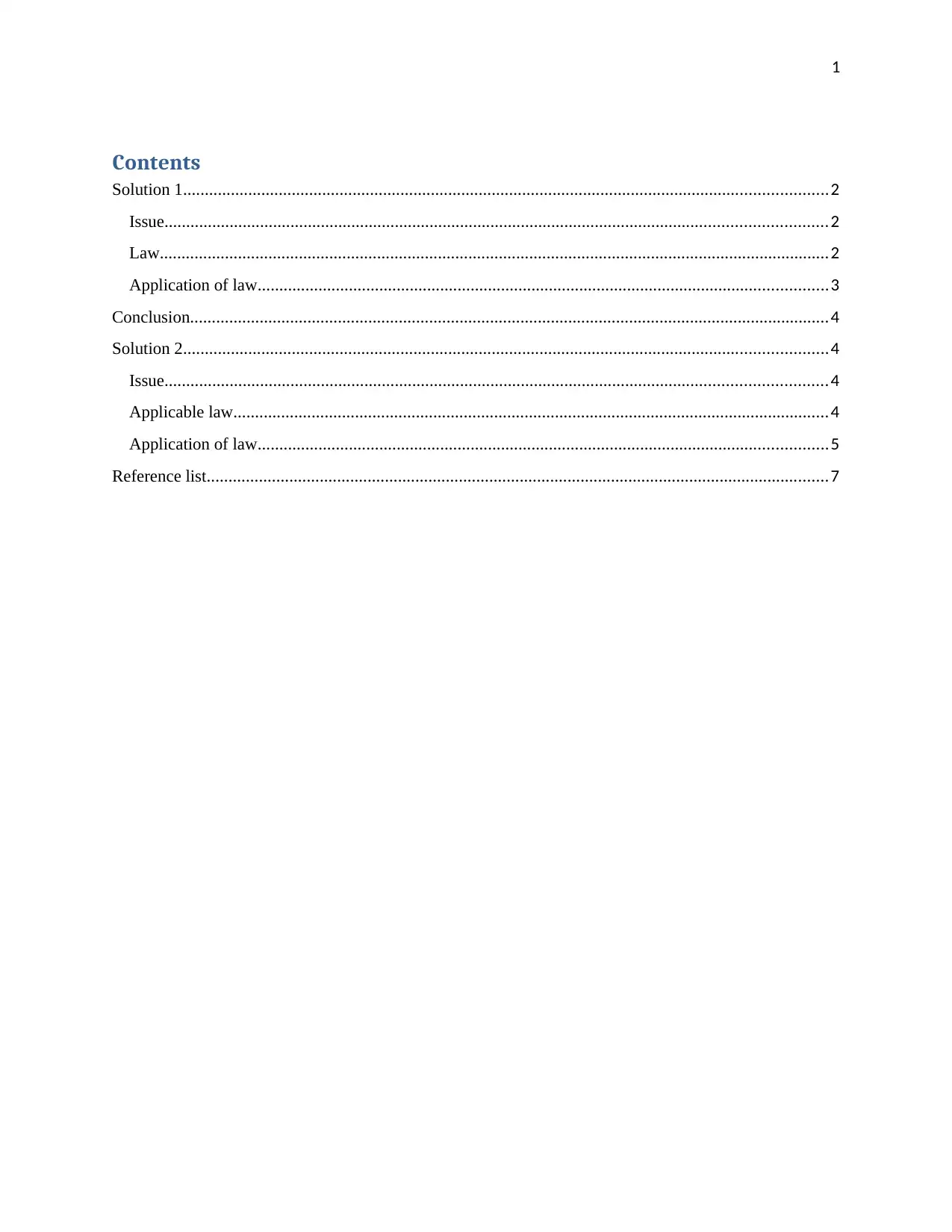
1
Contents
Solution 1....................................................................................................................................................2
Issue........................................................................................................................................................2
Law..........................................................................................................................................................2
Application of law...................................................................................................................................3
Conclusion...................................................................................................................................................4
Solution 2....................................................................................................................................................4
Issue........................................................................................................................................................4
Applicable law.........................................................................................................................................4
Application of law...................................................................................................................................5
Reference list...............................................................................................................................................7
Contents
Solution 1....................................................................................................................................................2
Issue........................................................................................................................................................2
Law..........................................................................................................................................................2
Application of law...................................................................................................................................3
Conclusion...................................................................................................................................................4
Solution 2....................................................................................................................................................4
Issue........................................................................................................................................................4
Applicable law.........................................................................................................................................4
Application of law...................................................................................................................................5
Reference list...............................................................................................................................................7
Paraphrase This Document
Need a fresh take? Get an instant paraphrase of this document with our AI Paraphraser
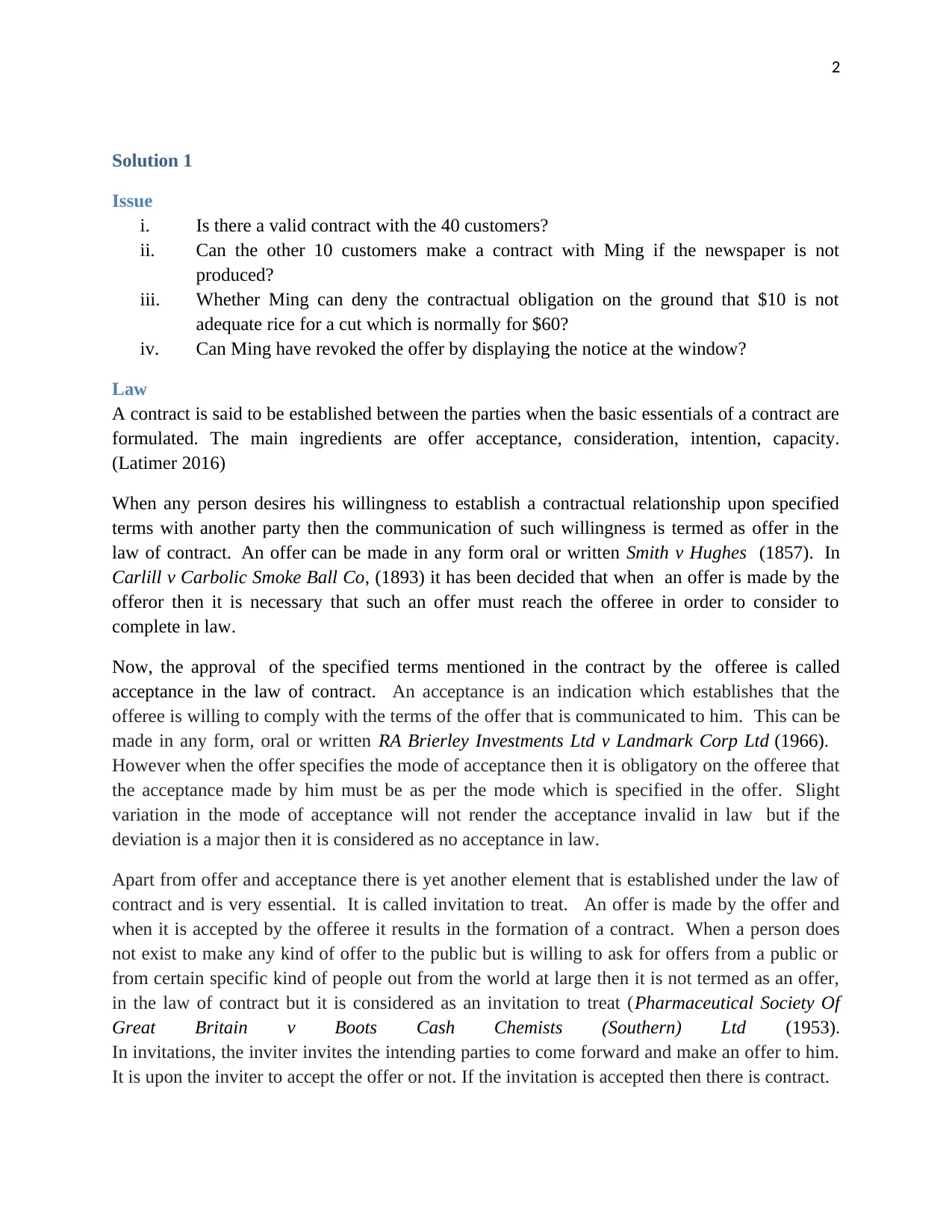
2
Solution 1
Issue
i. Is there a valid contract with the 40 customers?
ii. Can the other 10 customers make a contract with Ming if the newspaper is not
produced?
iii. Whether Ming can deny the contractual obligation on the ground that $10 is not
adequate rice for a cut which is normally for $60?
iv. Can Ming have revoked the offer by displaying the notice at the window?
Law
A contract is said to be established between the parties when the basic essentials of a contract are
formulated. The main ingredients are offer acceptance, consideration, intention, capacity.
(Latimer 2016)
When any person desires his willingness to establish a contractual relationship upon specified
terms with another party then the communication of such willingness is termed as offer in the
law of contract. An offer can be made in any form oral or written Smith v Hughes (1857). In
Carlill v Carbolic Smoke Ball Co, (1893) it has been decided that when an offer is made by the
offeror then it is necessary that such an offer must reach the offeree in order to consider to
complete in law.
Now, the approval of the specified terms mentioned in the contract by the offeree is called
acceptance in the law of contract. An acceptance is an indication which establishes that the
offeree is willing to comply with the terms of the offer that is communicated to him. This can be
made in any form, oral or written RA Brierley Investments Ltd v Landmark Corp Ltd (1966).
However when the offer specifies the mode of acceptance then it is obligatory on the offeree that
the acceptance made by him must be as per the mode which is specified in the offer. Slight
variation in the mode of acceptance will not render the acceptance invalid in law but if the
deviation is a major then it is considered as no acceptance in law.
Apart from offer and acceptance there is yet another element that is established under the law of
contract and is very essential. It is called invitation to treat. An offer is made by the offer and
when it is accepted by the offeree it results in the formation of a contract. When a person does
not exist to make any kind of offer to the public but is willing to ask for offers from a public or
from certain specific kind of people out from the world at large then it is not termed as an offer,
in the law of contract but it is considered as an invitation to treat (Pharmaceutical Society Of
Great Britain v Boots Cash Chemists (Southern) Ltd (1953).
In invitations, the inviter invites the intending parties to come forward and make an offer to him.
It is upon the inviter to accept the offer or not. If the invitation is accepted then there is contract.
Solution 1
Issue
i. Is there a valid contract with the 40 customers?
ii. Can the other 10 customers make a contract with Ming if the newspaper is not
produced?
iii. Whether Ming can deny the contractual obligation on the ground that $10 is not
adequate rice for a cut which is normally for $60?
iv. Can Ming have revoked the offer by displaying the notice at the window?
Law
A contract is said to be established between the parties when the basic essentials of a contract are
formulated. The main ingredients are offer acceptance, consideration, intention, capacity.
(Latimer 2016)
When any person desires his willingness to establish a contractual relationship upon specified
terms with another party then the communication of such willingness is termed as offer in the
law of contract. An offer can be made in any form oral or written Smith v Hughes (1857). In
Carlill v Carbolic Smoke Ball Co, (1893) it has been decided that when an offer is made by the
offeror then it is necessary that such an offer must reach the offeree in order to consider to
complete in law.
Now, the approval of the specified terms mentioned in the contract by the offeree is called
acceptance in the law of contract. An acceptance is an indication which establishes that the
offeree is willing to comply with the terms of the offer that is communicated to him. This can be
made in any form, oral or written RA Brierley Investments Ltd v Landmark Corp Ltd (1966).
However when the offer specifies the mode of acceptance then it is obligatory on the offeree that
the acceptance made by him must be as per the mode which is specified in the offer. Slight
variation in the mode of acceptance will not render the acceptance invalid in law but if the
deviation is a major then it is considered as no acceptance in law.
Apart from offer and acceptance there is yet another element that is established under the law of
contract and is very essential. It is called invitation to treat. An offer is made by the offer and
when it is accepted by the offeree it results in the formation of a contract. When a person does
not exist to make any kind of offer to the public but is willing to ask for offers from a public or
from certain specific kind of people out from the world at large then it is not termed as an offer,
in the law of contract but it is considered as an invitation to treat (Pharmaceutical Society Of
Great Britain v Boots Cash Chemists (Southern) Ltd (1953).
In invitations, the inviter invites the intending parties to come forward and make an offer to him.
It is upon the inviter to accept the offer or not. If the invitation is accepted then there is contract.
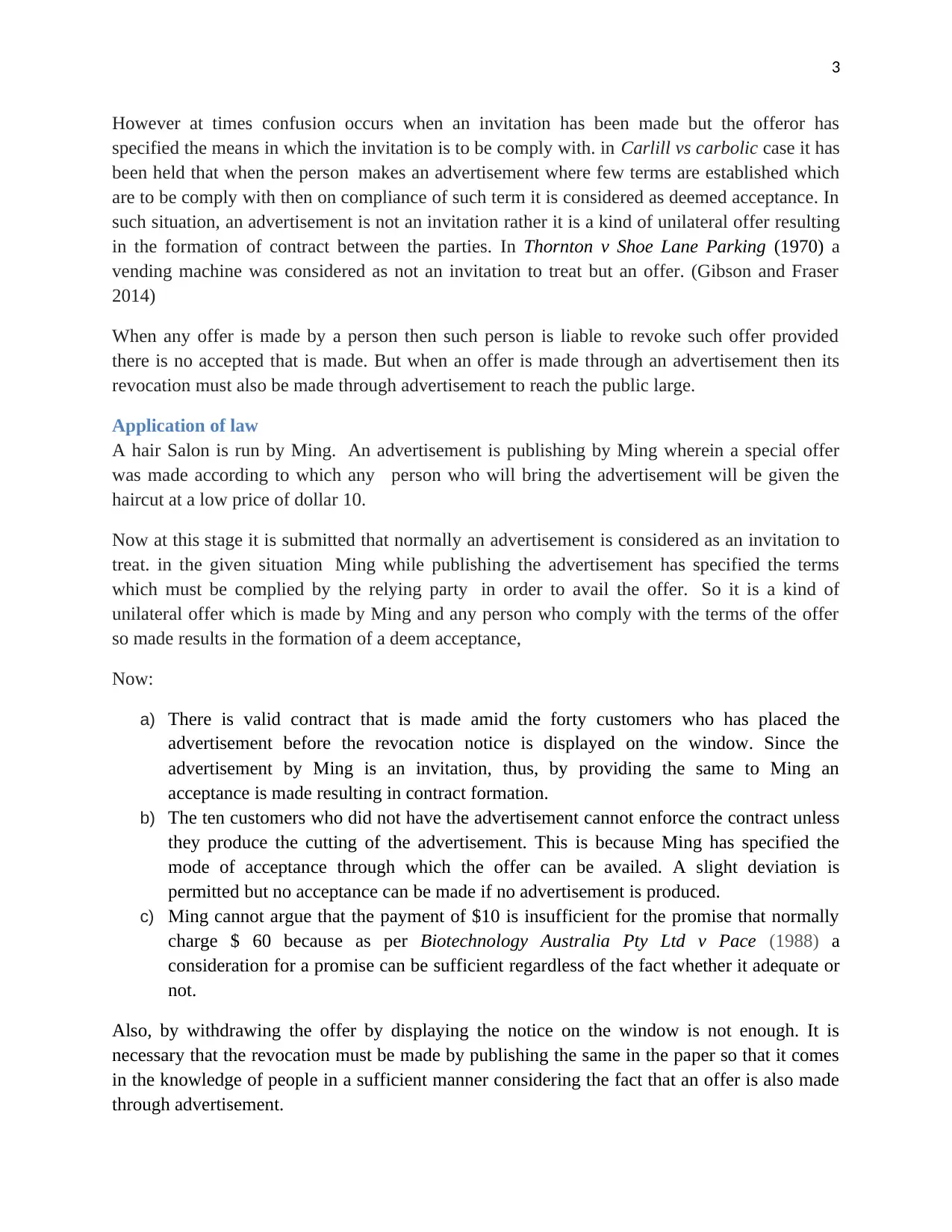
3
However at times confusion occurs when an invitation has been made but the offeror has
specified the means in which the invitation is to be comply with. in Carlill vs carbolic case it has
been held that when the person makes an advertisement where few terms are established which
are to be comply with then on compliance of such term it is considered as deemed acceptance. In
such situation, an advertisement is not an invitation rather it is a kind of unilateral offer resulting
in the formation of contract between the parties. In Thornton v Shoe Lane Parking (1970) a
vending machine was considered as not an invitation to treat but an offer. (Gibson and Fraser
2014)
When any offer is made by a person then such person is liable to revoke such offer provided
there is no accepted that is made. But when an offer is made through an advertisement then its
revocation must also be made through advertisement to reach the public large.
Application of law
A hair Salon is run by Ming. An advertisement is publishing by Ming wherein a special offer
was made according to which any person who will bring the advertisement will be given the
haircut at a low price of dollar 10.
Now at this stage it is submitted that normally an advertisement is considered as an invitation to
treat. in the given situation Ming while publishing the advertisement has specified the terms
which must be complied by the relying party in order to avail the offer. So it is a kind of
unilateral offer which is made by Ming and any person who comply with the terms of the offer
so made results in the formation of a deem acceptance,
Now:
a) There is valid contract that is made amid the forty customers who has placed the
advertisement before the revocation notice is displayed on the window. Since the
advertisement by Ming is an invitation, thus, by providing the same to Ming an
acceptance is made resulting in contract formation.
b) The ten customers who did not have the advertisement cannot enforce the contract unless
they produce the cutting of the advertisement. This is because Ming has specified the
mode of acceptance through which the offer can be availed. A slight deviation is
permitted but no acceptance can be made if no advertisement is produced.
c) Ming cannot argue that the payment of $10 is insufficient for the promise that normally
charge $ 60 because as per Biotechnology Australia Pty Ltd v Pace (1988) a
consideration for a promise can be sufficient regardless of the fact whether it adequate or
not.
Also, by withdrawing the offer by displaying the notice on the window is not enough. It is
necessary that the revocation must be made by publishing the same in the paper so that it comes
in the knowledge of people in a sufficient manner considering the fact that an offer is also made
through advertisement.
However at times confusion occurs when an invitation has been made but the offeror has
specified the means in which the invitation is to be comply with. in Carlill vs carbolic case it has
been held that when the person makes an advertisement where few terms are established which
are to be comply with then on compliance of such term it is considered as deemed acceptance. In
such situation, an advertisement is not an invitation rather it is a kind of unilateral offer resulting
in the formation of contract between the parties. In Thornton v Shoe Lane Parking (1970) a
vending machine was considered as not an invitation to treat but an offer. (Gibson and Fraser
2014)
When any offer is made by a person then such person is liable to revoke such offer provided
there is no accepted that is made. But when an offer is made through an advertisement then its
revocation must also be made through advertisement to reach the public large.
Application of law
A hair Salon is run by Ming. An advertisement is publishing by Ming wherein a special offer
was made according to which any person who will bring the advertisement will be given the
haircut at a low price of dollar 10.
Now at this stage it is submitted that normally an advertisement is considered as an invitation to
treat. in the given situation Ming while publishing the advertisement has specified the terms
which must be complied by the relying party in order to avail the offer. So it is a kind of
unilateral offer which is made by Ming and any person who comply with the terms of the offer
so made results in the formation of a deem acceptance,
Now:
a) There is valid contract that is made amid the forty customers who has placed the
advertisement before the revocation notice is displayed on the window. Since the
advertisement by Ming is an invitation, thus, by providing the same to Ming an
acceptance is made resulting in contract formation.
b) The ten customers who did not have the advertisement cannot enforce the contract unless
they produce the cutting of the advertisement. This is because Ming has specified the
mode of acceptance through which the offer can be availed. A slight deviation is
permitted but no acceptance can be made if no advertisement is produced.
c) Ming cannot argue that the payment of $10 is insufficient for the promise that normally
charge $ 60 because as per Biotechnology Australia Pty Ltd v Pace (1988) a
consideration for a promise can be sufficient regardless of the fact whether it adequate or
not.
Also, by withdrawing the offer by displaying the notice on the window is not enough. It is
necessary that the revocation must be made by publishing the same in the paper so that it comes
in the knowledge of people in a sufficient manner considering the fact that an offer is also made
through advertisement.
⊘ This is a preview!⊘
Do you want full access?
Subscribe today to unlock all pages.

Trusted by 1+ million students worldwide
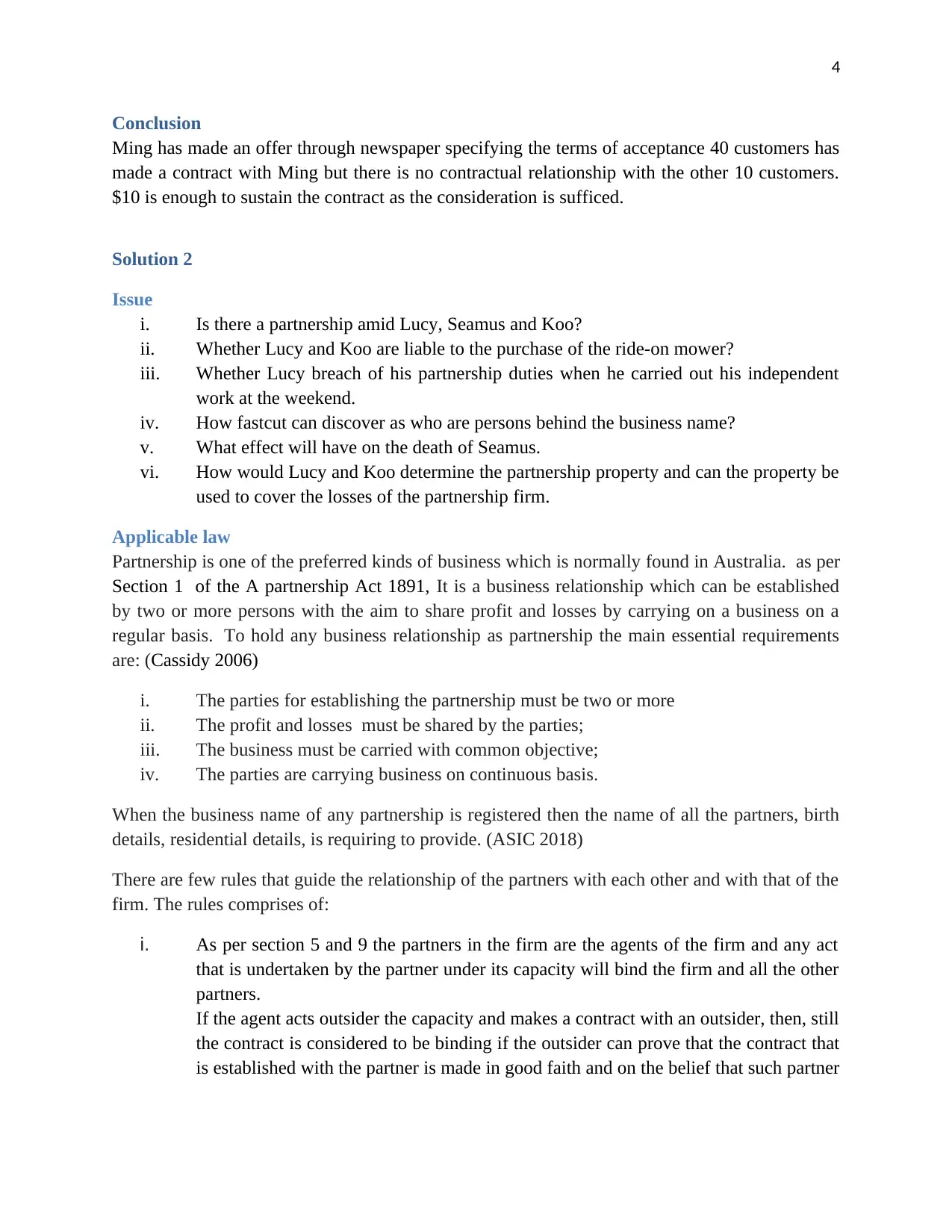
4
Conclusion
Ming has made an offer through newspaper specifying the terms of acceptance 40 customers has
made a contract with Ming but there is no contractual relationship with the other 10 customers.
$10 is enough to sustain the contract as the consideration is sufficed.
Solution 2
Issue
i. Is there a partnership amid Lucy, Seamus and Koo?
ii. Whether Lucy and Koo are liable to the purchase of the ride-on mower?
iii. Whether Lucy breach of his partnership duties when he carried out his independent
work at the weekend.
iv. How fastcut can discover as who are persons behind the business name?
v. What effect will have on the death of Seamus.
vi. How would Lucy and Koo determine the partnership property and can the property be
used to cover the losses of the partnership firm.
Applicable law
Partnership is one of the preferred kinds of business which is normally found in Australia. as per
Section 1 of the A partnership Act 1891, It is a business relationship which can be established
by two or more persons with the aim to share profit and losses by carrying on a business on a
regular basis. To hold any business relationship as partnership the main essential requirements
are: (Cassidy 2006)
i. The parties for establishing the partnership must be two or more
ii. The profit and losses must be shared by the parties;
iii. The business must be carried with common objective;
iv. The parties are carrying business on continuous basis.
When the business name of any partnership is registered then the name of all the partners, birth
details, residential details, is requiring to provide. (ASIC 2018)
There are few rules that guide the relationship of the partners with each other and with that of the
firm. The rules comprises of:
i. As per section 5 and 9 the partners in the firm are the agents of the firm and any act
that is undertaken by the partner under its capacity will bind the firm and all the other
partners.
If the agent acts outsider the capacity and makes a contract with an outsider, then, still
the contract is considered to be binding if the outsider can prove that the contract that
is established with the partner is made in good faith and on the belief that such partner
Conclusion
Ming has made an offer through newspaper specifying the terms of acceptance 40 customers has
made a contract with Ming but there is no contractual relationship with the other 10 customers.
$10 is enough to sustain the contract as the consideration is sufficed.
Solution 2
Issue
i. Is there a partnership amid Lucy, Seamus and Koo?
ii. Whether Lucy and Koo are liable to the purchase of the ride-on mower?
iii. Whether Lucy breach of his partnership duties when he carried out his independent
work at the weekend.
iv. How fastcut can discover as who are persons behind the business name?
v. What effect will have on the death of Seamus.
vi. How would Lucy and Koo determine the partnership property and can the property be
used to cover the losses of the partnership firm.
Applicable law
Partnership is one of the preferred kinds of business which is normally found in Australia. as per
Section 1 of the A partnership Act 1891, It is a business relationship which can be established
by two or more persons with the aim to share profit and losses by carrying on a business on a
regular basis. To hold any business relationship as partnership the main essential requirements
are: (Cassidy 2006)
i. The parties for establishing the partnership must be two or more
ii. The profit and losses must be shared by the parties;
iii. The business must be carried with common objective;
iv. The parties are carrying business on continuous basis.
When the business name of any partnership is registered then the name of all the partners, birth
details, residential details, is requiring to provide. (ASIC 2018)
There are few rules that guide the relationship of the partners with each other and with that of the
firm. The rules comprises of:
i. As per section 5 and 9 the partners in the firm are the agents of the firm and any act
that is undertaken by the partner under its capacity will bind the firm and all the other
partners.
If the agent acts outsider the capacity and makes a contract with an outsider, then, still
the contract is considered to be binding if the outsider can prove that the contract that
is established with the partner is made in good faith and on the belief that such partner
Paraphrase This Document
Need a fresh take? Get an instant paraphrase of this document with our AI Paraphraser
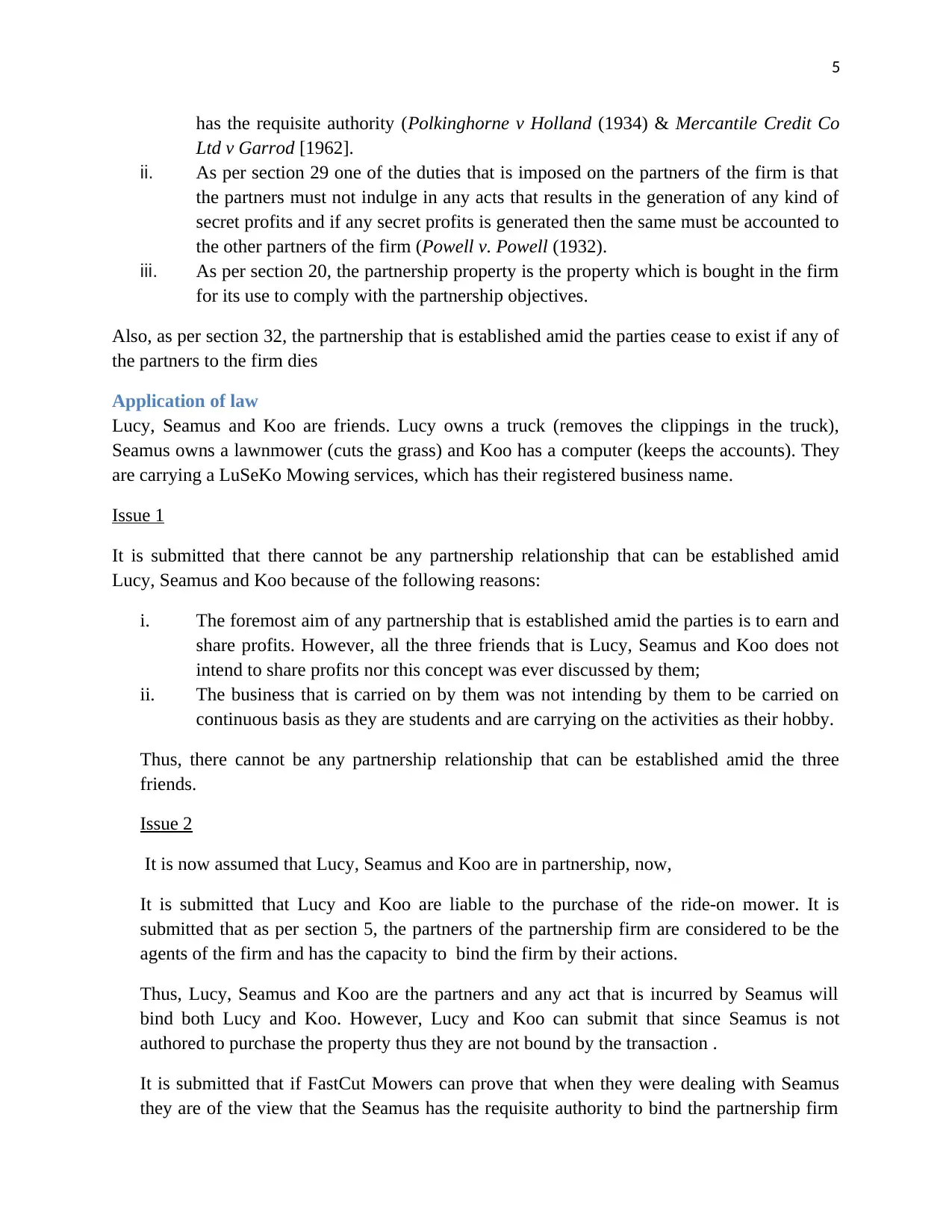
5
has the requisite authority (Polkinghorne v Holland (1934) & Mercantile Credit Co
Ltd v Garrod [1962].
ii. As per section 29 one of the duties that is imposed on the partners of the firm is that
the partners must not indulge in any acts that results in the generation of any kind of
secret profits and if any secret profits is generated then the same must be accounted to
the other partners of the firm (Powell v. Powell (1932).
iii. As per section 20, the partnership property is the property which is bought in the firm
for its use to comply with the partnership objectives.
Also, as per section 32, the partnership that is established amid the parties cease to exist if any of
the partners to the firm dies
Application of law
Lucy, Seamus and Koo are friends. Lucy owns a truck (removes the clippings in the truck),
Seamus owns a lawnmower (cuts the grass) and Koo has a computer (keeps the accounts). They
are carrying a LuSeKo Mowing services, which has their registered business name.
Issue 1
It is submitted that there cannot be any partnership relationship that can be established amid
Lucy, Seamus and Koo because of the following reasons:
i. The foremost aim of any partnership that is established amid the parties is to earn and
share profits. However, all the three friends that is Lucy, Seamus and Koo does not
intend to share profits nor this concept was ever discussed by them;
ii. The business that is carried on by them was not intending by them to be carried on
continuous basis as they are students and are carrying on the activities as their hobby.
Thus, there cannot be any partnership relationship that can be established amid the three
friends.
Issue 2
It is now assumed that Lucy, Seamus and Koo are in partnership, now,
It is submitted that Lucy and Koo are liable to the purchase of the ride-on mower. It is
submitted that as per section 5, the partners of the partnership firm are considered to be the
agents of the firm and has the capacity to bind the firm by their actions.
Thus, Lucy, Seamus and Koo are the partners and any act that is incurred by Seamus will
bind both Lucy and Koo. However, Lucy and Koo can submit that since Seamus is not
authored to purchase the property thus they are not bound by the transaction .
It is submitted that if FastCut Mowers can prove that when they were dealing with Seamus
they are of the view that the Seamus has the requisite authority to bind the partnership firm
has the requisite authority (Polkinghorne v Holland (1934) & Mercantile Credit Co
Ltd v Garrod [1962].
ii. As per section 29 one of the duties that is imposed on the partners of the firm is that
the partners must not indulge in any acts that results in the generation of any kind of
secret profits and if any secret profits is generated then the same must be accounted to
the other partners of the firm (Powell v. Powell (1932).
iii. As per section 20, the partnership property is the property which is bought in the firm
for its use to comply with the partnership objectives.
Also, as per section 32, the partnership that is established amid the parties cease to exist if any of
the partners to the firm dies
Application of law
Lucy, Seamus and Koo are friends. Lucy owns a truck (removes the clippings in the truck),
Seamus owns a lawnmower (cuts the grass) and Koo has a computer (keeps the accounts). They
are carrying a LuSeKo Mowing services, which has their registered business name.
Issue 1
It is submitted that there cannot be any partnership relationship that can be established amid
Lucy, Seamus and Koo because of the following reasons:
i. The foremost aim of any partnership that is established amid the parties is to earn and
share profits. However, all the three friends that is Lucy, Seamus and Koo does not
intend to share profits nor this concept was ever discussed by them;
ii. The business that is carried on by them was not intending by them to be carried on
continuous basis as they are students and are carrying on the activities as their hobby.
Thus, there cannot be any partnership relationship that can be established amid the three
friends.
Issue 2
It is now assumed that Lucy, Seamus and Koo are in partnership, now,
It is submitted that Lucy and Koo are liable to the purchase of the ride-on mower. It is
submitted that as per section 5, the partners of the partnership firm are considered to be the
agents of the firm and has the capacity to bind the firm by their actions.
Thus, Lucy, Seamus and Koo are the partners and any act that is incurred by Seamus will
bind both Lucy and Koo. However, Lucy and Koo can submit that since Seamus is not
authored to purchase the property thus they are not bound by the transaction .
It is submitted that if FastCut Mowers can prove that when they were dealing with Seamus
they are of the view that the Seamus has the requisite authority to bind the partnership firm
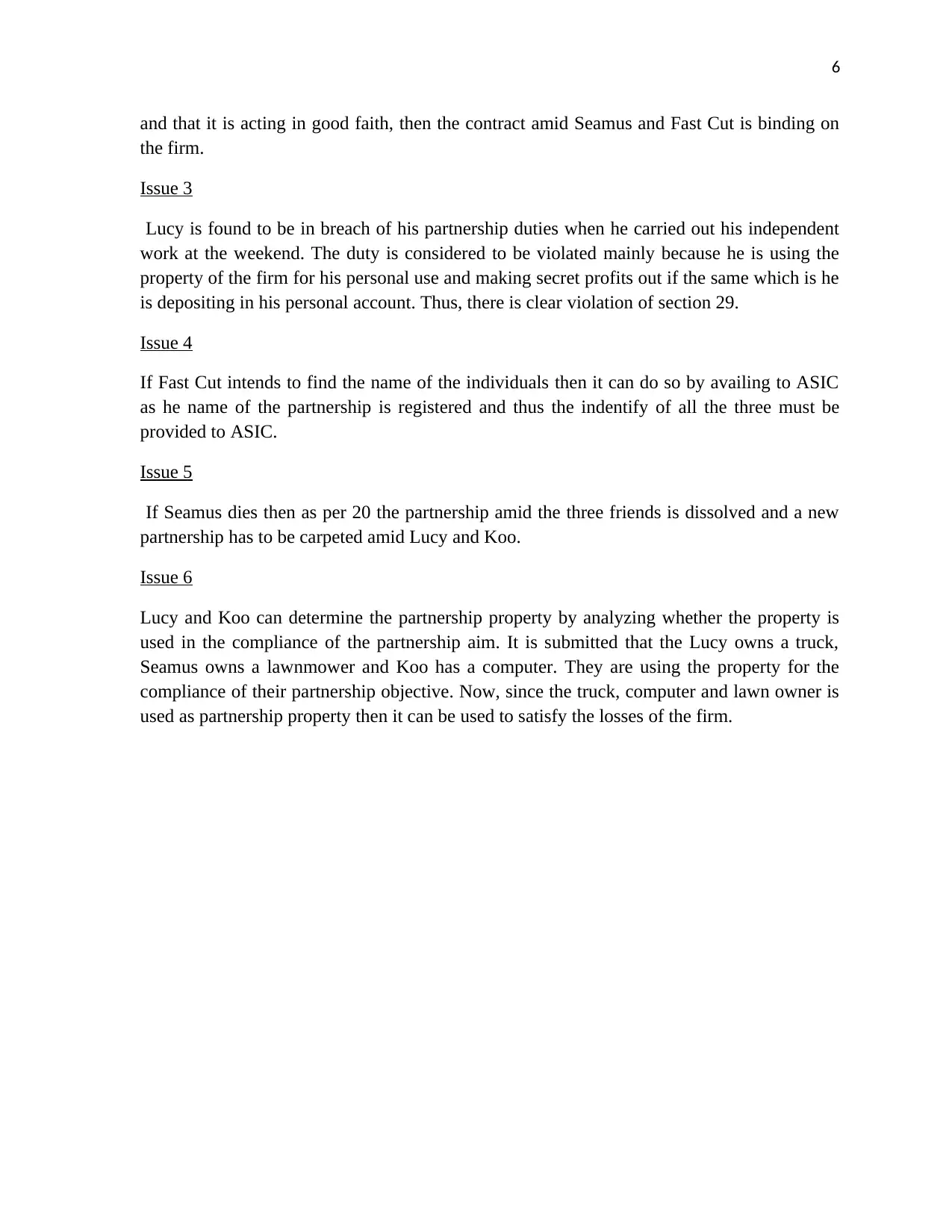
6
and that it is acting in good faith, then the contract amid Seamus and Fast Cut is binding on
the firm.
Issue 3
Lucy is found to be in breach of his partnership duties when he carried out his independent
work at the weekend. The duty is considered to be violated mainly because he is using the
property of the firm for his personal use and making secret profits out if the same which is he
is depositing in his personal account. Thus, there is clear violation of section 29.
Issue 4
If Fast Cut intends to find the name of the individuals then it can do so by availing to ASIC
as he name of the partnership is registered and thus the indentify of all the three must be
provided to ASIC.
Issue 5
If Seamus dies then as per 20 the partnership amid the three friends is dissolved and a new
partnership has to be carpeted amid Lucy and Koo.
Issue 6
Lucy and Koo can determine the partnership property by analyzing whether the property is
used in the compliance of the partnership aim. It is submitted that the Lucy owns a truck,
Seamus owns a lawnmower and Koo has a computer. They are using the property for the
compliance of their partnership objective. Now, since the truck, computer and lawn owner is
used as partnership property then it can be used to satisfy the losses of the firm.
and that it is acting in good faith, then the contract amid Seamus and Fast Cut is binding on
the firm.
Issue 3
Lucy is found to be in breach of his partnership duties when he carried out his independent
work at the weekend. The duty is considered to be violated mainly because he is using the
property of the firm for his personal use and making secret profits out if the same which is he
is depositing in his personal account. Thus, there is clear violation of section 29.
Issue 4
If Fast Cut intends to find the name of the individuals then it can do so by availing to ASIC
as he name of the partnership is registered and thus the indentify of all the three must be
provided to ASIC.
Issue 5
If Seamus dies then as per 20 the partnership amid the three friends is dissolved and a new
partnership has to be carpeted amid Lucy and Koo.
Issue 6
Lucy and Koo can determine the partnership property by analyzing whether the property is
used in the compliance of the partnership aim. It is submitted that the Lucy owns a truck,
Seamus owns a lawnmower and Koo has a computer. They are using the property for the
compliance of their partnership objective. Now, since the truck, computer and lawn owner is
used as partnership property then it can be used to satisfy the losses of the firm.
⊘ This is a preview!⊘
Do you want full access?
Subscribe today to unlock all pages.

Trusted by 1+ million students worldwide
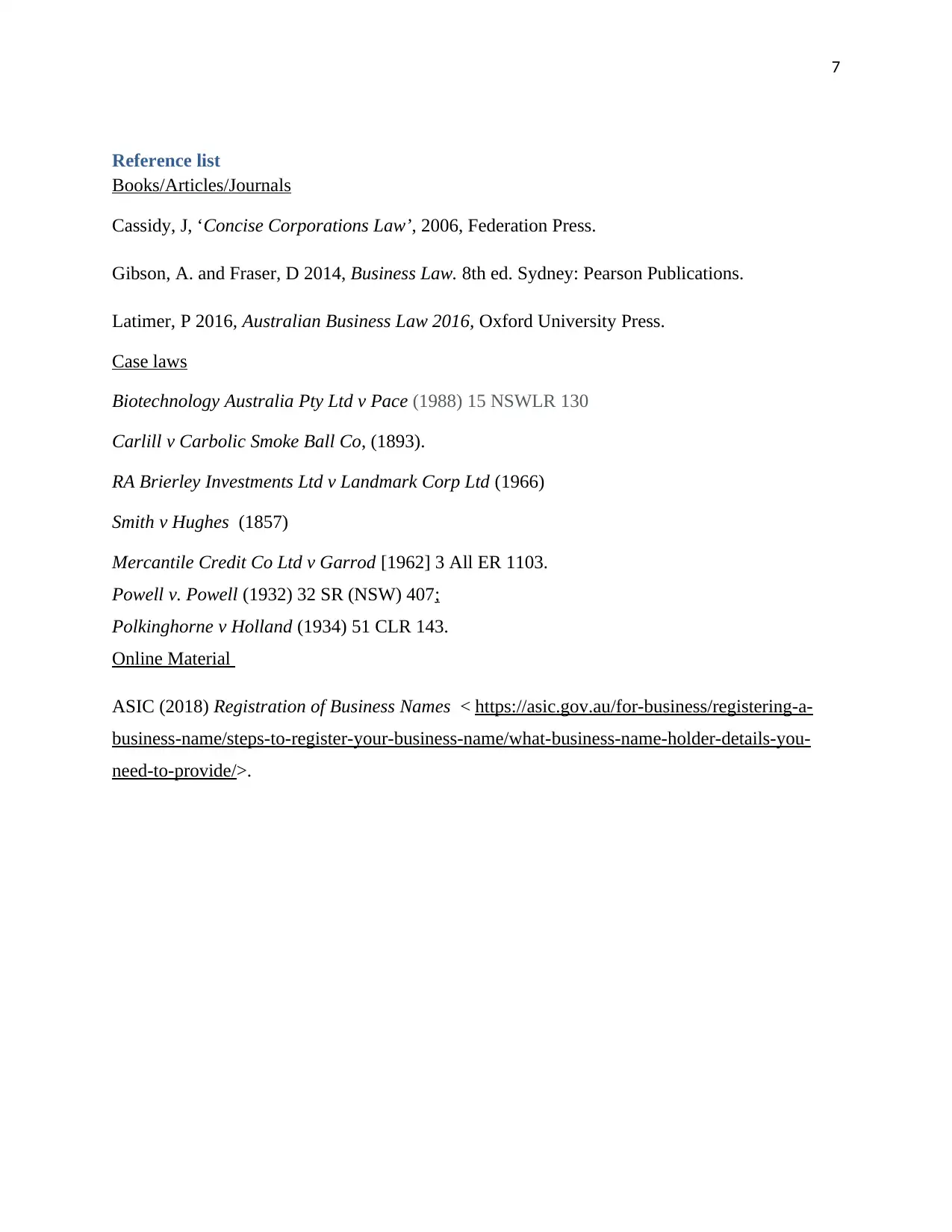
7
Reference list
Books/Articles/Journals
Cassidy, J, ‘Concise Corporations Law’, 2006, Federation Press.
Gibson, A. and Fraser, D 2014, Business Law. 8th ed. Sydney: Pearson Publications.
Latimer, P 2016, Australian Business Law 2016, Oxford University Press.
Case laws
Biotechnology Australia Pty Ltd v Pace (1988) 15 NSWLR 130
Carlill v Carbolic Smoke Ball Co, (1893).
RA Brierley Investments Ltd v Landmark Corp Ltd (1966)
Smith v Hughes (1857)
Mercantile Credit Co Ltd v Garrod [1962] 3 All ER 1103.
Powell v. Powell (1932) 32 SR (NSW) 407;
Polkinghorne v Holland (1934) 51 CLR 143.
Online Material
ASIC (2018) Registration of Business Names < https://asic.gov.au/for-business/registering-a-
business-name/steps-to-register-your-business-name/what-business-name-holder-details-you-
need-to-provide/>.
Reference list
Books/Articles/Journals
Cassidy, J, ‘Concise Corporations Law’, 2006, Federation Press.
Gibson, A. and Fraser, D 2014, Business Law. 8th ed. Sydney: Pearson Publications.
Latimer, P 2016, Australian Business Law 2016, Oxford University Press.
Case laws
Biotechnology Australia Pty Ltd v Pace (1988) 15 NSWLR 130
Carlill v Carbolic Smoke Ball Co, (1893).
RA Brierley Investments Ltd v Landmark Corp Ltd (1966)
Smith v Hughes (1857)
Mercantile Credit Co Ltd v Garrod [1962] 3 All ER 1103.
Powell v. Powell (1932) 32 SR (NSW) 407;
Polkinghorne v Holland (1934) 51 CLR 143.
Online Material
ASIC (2018) Registration of Business Names < https://asic.gov.au/for-business/registering-a-
business-name/steps-to-register-your-business-name/what-business-name-holder-details-you-
need-to-provide/>.
1 out of 7
Related Documents
Your All-in-One AI-Powered Toolkit for Academic Success.
+13062052269
info@desklib.com
Available 24*7 on WhatsApp / Email
![[object Object]](/_next/static/media/star-bottom.7253800d.svg)
Unlock your academic potential
Copyright © 2020–2025 A2Z Services. All Rights Reserved. Developed and managed by ZUCOL.




